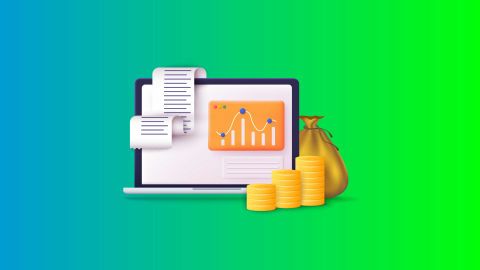3 min
18-September-2024
A gold ETF can be defined as an exchange-traded fund which primarily tracks the price of domestic physical gold. To put it simply, in other words, a gold ETF represents physical gold which is on paper or in a dematerialised form. Gold ETFs are managed passively, and invest in gold bullion. One gold ETF equals 1 gram of gold, and is backed by very high purity physical gold. In this article, we will first understand “what is gold ETF”, what taxation rules apply to them, their purpose, and more.
When you are investing in exchange-traded funds, you are essentially putting your money into assets, which, in this case, represent physical gold. Instead of purchasing actual physical gold, you invest in stocks that are linked to the value of gold. These stocks can be held in both dematerialised and paper form. When you decide to trade gold ETFs, you will be credited with the equivalent value of gold in cash, which reflects the current market price of the gold represented by your ETF units. This would allow you to benefit from the value of gold without the need to store or manage it in its physical form.
Gold ETFs also serve as a hedge against a volatile market, making them a valuable alternative to traditional insurance in your investment portfolio. For instance, you can use short-term exchange-traded funds to minimise potential losses if the price of gold suddenly drops.
These exchange-traded funds are regarded as some of the best defensive assets available, sharing characteristics similar to bonds. Many investors use them to safeguard their investments against economic fluctuations and, in extreme cases, currency debasement. The price of gold can rise significantly if major currencies, like the dollar, weaken, allowing you to potentially profit from such shifts.
Each unit of these traded funds represents 1 gram of 99.5% pure gold, making them an ideal long-term investment, especially if you choose to invest large sums or trade systematically over time.
Like other stocks, you can buy and sell shares of the ETF on the stock exchange, allowing you to trade throughout the day and manage your investment easily. This makes gold ETFs a convenient option for both short-term and long-term strategies, providing straightforward access to the gold market.
Gold ETFs are governed by SEBI Mutual Funds Regulations, ensuring a level of oversight and protection for investors like you. Additionally, fund houses are required to undergo regular audits of the physical gold they purchase, conducted by a statutory auditor. This mandatory audit process helps to verify that the gold backing your ETF is accurately accounted for, providing you with greater transparency and confidence in your investment.
For gold ETFs, the long-term capital gains (LTCG) period is 12 months, and these gains are taxed at 12.5% without indexation. Additionally, your short-term capital gains (STCG) tax on specified financial assets has risen from 15% to 20%.
Since gold ETFs come in various denominations, they are suitable for all types of investors. You can start investing with as little as one unit of the traded fund, which represents one gram of gold. This flexibility makes gold ETFs accessible, whether you are just starting out or looking to diversify your portfolio.
If you are looking for a way to benefit from gold's market dynamics without the complexities of handling physical gold, gold ETFs could be the ideal investment for you. Over the past few years, gold-based ETFs have consistently outperformed benchmark stock indices, making them a particularly attractive option for conservative investors who seek steady returns.
Furthermore, with brokerage fees ranging from just 0.5% to 1%, gold ETFs are cost-effective, making them a smart choice if you are looking to minimise commission charges. By investing in gold ETFs, you can enjoy the benefits of gold's market movements while keeping your investment costs low.
To make your investment journey even smoother and continue investing in mutual funds, consider using the Bajaj Finserv Mutual Fund platform. With over 1,000 mutual fund schemes listed, the platform provides a user-friendly interface where you can easily explore and invest in a wide range of mutual funds, including gold ETFs. The platform offers tools and resources such as a mutual fund calculator to help you compare mutual funds, and make informed decisions, track your investments, and manage your portfolio effectively
What is gold ETF?
A gold ETF, also known as a Gold Exchange Traded Fund, can be defined as a commodity-based mutual fund which invests in assets like gold. Such an exchange-traded fund performs the same as an individual stock and can be traded in a similar manner on the stock exchange.When you are investing in exchange-traded funds, you are essentially putting your money into assets, which, in this case, represent physical gold. Instead of purchasing actual physical gold, you invest in stocks that are linked to the value of gold. These stocks can be held in both dematerialised and paper form. When you decide to trade gold ETFs, you will be credited with the equivalent value of gold in cash, which reflects the current market price of the gold represented by your ETF units. This would allow you to benefit from the value of gold without the need to store or manage it in its physical form.
Purpose of gold ETF
Even though gold ETFs are commodity-based traded funds, you can also use them as industry exchange-traded funds. This makes them an excellent strategy to diversify your financial portfolio and gain exposure to various sectors, including gold mining, manufacturing, and the transport industry. These traded funds are relatively simple to acquire, offering an easier way for you to invest in the gold industry.Gold ETFs also serve as a hedge against a volatile market, making them a valuable alternative to traditional insurance in your investment portfolio. For instance, you can use short-term exchange-traded funds to minimise potential losses if the price of gold suddenly drops.
These exchange-traded funds are regarded as some of the best defensive assets available, sharing characteristics similar to bonds. Many investors use them to safeguard their investments against economic fluctuations and, in extreme cases, currency debasement. The price of gold can rise significantly if major currencies, like the dollar, weaken, allowing you to potentially profit from such shifts.
Each unit of these traded funds represents 1 gram of 99.5% pure gold, making them an ideal long-term investment, especially if you choose to invest large sums or trade systematically over time.
How does gold ETF work?
A gold ETF is a fund that holds assets such as gold bullions or future contracts and can be traded on stock exchanges. In this case, the value of an ETF is directly linked to the price of gold. For example, if the gold price increases by 2%, the value of your gold ETF is likely to rise by a similar amount. Conversely, if the gold price falls, the ETF's value is expected to decrease as well.Like other stocks, you can buy and sell shares of the ETF on the stock exchange, allowing you to trade throughout the day and manage your investment easily. This makes gold ETFs a convenient option for both short-term and long-term strategies, providing straightforward access to the gold market.
Risks of gold ETF
When you invest in gold ETFs, it's important to be aware that they are subject to market risks that can affect the price of gold. As with any investment tied to market performance, the value of your gold ETF can fluctuate based on changes in the gold market.Gold ETFs are governed by SEBI Mutual Funds Regulations, ensuring a level of oversight and protection for investors like you. Additionally, fund houses are required to undergo regular audits of the physical gold they purchase, conducted by a statutory auditor. This mandatory audit process helps to verify that the gold backing your ETF is accurately accounted for, providing you with greater transparency and confidence in your investment.
What is gold ETF taxation?
Taxes on gold ETFs are similar to those on buying or selling physical gold. If you trade these funds and make a profit, you will be required to pay capital gains tax, regardless of whether your investment is short-term or long-term.For gold ETFs, the long-term capital gains (LTCG) period is 12 months, and these gains are taxed at 12.5% without indexation. Additionally, your short-term capital gains (STCG) tax on specified financial assets has risen from 15% to 20%.
Advantages of investing in gold ETF
Investing in gold ETFs offers several advantages over purchasing physical gold. These funds are particularly suitable if you want to track and reflect the real-time price of gold without the burden of storing the physical metal. By investing in gold ETFs, you gain exposure to the price and performance of gold, making it a valuable option for boosting your income through trading. Here are some of the key advantages of investing in a gold ETF:1. Easier trading
The procedure for purchasing and selling a gold ETF is similar to any other equity-based fund. This makes the entire procedure easier, particularly if you are an investor trading stocks through a stockbroker or an ETF funds manager. Gold ETFs are easier to liquidate, and can be traded during working hours. Additionally, gold prices are available publicly in the stock exchange. This makes the entire procedure transparent, and allows you as an investor to track any changes, even on an hourly basis.2. No entry or exit loads
A gold ETF does not attract any entry loads or exit loads. This ensures that there are zero additional charges when you are purchasing or selling gold ETFs.3. Tax benefits
Apart from capital gains tax, gold exchange-traded funds do not attract any VAT, securities transaction tax, which allows you as an investor to save taxes on the investments you are making. When you invest in physical gold, it can make you liable to pay wealth taxes, specifically if you purchase a lot of gold jewellery or gold bullions. However, investing in a gold ETF does not attract any wealth taxes, which makes it a better option for saving taxes.4. Less market risks
Gold prices typically do not experience significant fluctuations, which helps protect you from major losses, even if equity returns decline substantially.Since gold ETFs come in various denominations, they are suitable for all types of investors. You can start investing with as little as one unit of the traded fund, which represents one gram of gold. This flexibility makes gold ETFs accessible, whether you are just starting out or looking to diversify your portfolio.
5. Collateral advantage
You can use gold ETFs as collateral when applying for a secured loan from any financial institution. This method offers greater convenience compared to traditional hypothecation, as the entire process is considerably quicker and less time-consuming. Using gold ETFs as collateral can be an efficient way to secure financing while maintaining your investment in gold.Who should invest in gold ETF?
Gold ETFs are an excellent choice if you want to track and reflect the real-time price of gold without the need to physically own the metal. These exchange-traded funds allow you to boost your income by trading on the value of gold, providing you with ample opportunities to gain market exposure to both the price and performance of actual gold.If you are looking for a way to benefit from gold's market dynamics without the complexities of handling physical gold, gold ETFs could be the ideal investment for you. Over the past few years, gold-based ETFs have consistently outperformed benchmark stock indices, making them a particularly attractive option for conservative investors who seek steady returns.
Furthermore, with brokerage fees ranging from just 0.5% to 1%, gold ETFs are cost-effective, making them a smart choice if you are looking to minimise commission charges. By investing in gold ETFs, you can enjoy the benefits of gold's market movements while keeping your investment costs low.
How to sell / redeem gold ETF?
When you are ready to redeem or sell your gold ETFs, you can do so through the stock exchange via your demat and trading accounts. Since these ETFs are backed by physical gold, they are best suited for benefiting from gold's price movements rather than obtaining the physical metal itself. Upon liquidation, you will be paid based on the domestic market price of gold. Some Asset Management Companies (AMCs) also allow redemption in physical gold for those holding ETF units equivalent to 1 kg of gold or more, in what is known as 'Creation Unit' size.Conclusion
In conclusion, gold ETF offer a convenient and efficient way for you to invest in gold without the need to handle the physical commodity. They provide real-time tracking of gold prices, making them an ideal choice for investors who want to gain exposure to the precious metal while maintaining flexibility and ease of trading. With lower brokerage fees and the potential to outperform traditional investments, a gold ETF is a strong addition to a diversified portfolio, especially for those looking to hedge against market volatility or protect their wealth.To make your investment journey even smoother and continue investing in mutual funds, consider using the Bajaj Finserv Mutual Fund platform. With over 1,000 mutual fund schemes listed, the platform provides a user-friendly interface where you can easily explore and invest in a wide range of mutual funds, including gold ETFs. The platform offers tools and resources such as a mutual fund calculator to help you compare mutual funds, and make informed decisions, track your investments, and manage your portfolio effectively
Essential tools for all mutual fund investors
| Lumpsum Calculator | Systematic Investment Plan Calculator | Step Up SIP Calculator | Tata SIP Calculator |
| SBI SIP Calculator | HDFC SIP Calculator | Nippon India SIP Calculator | ABSL SIP Calculator |




